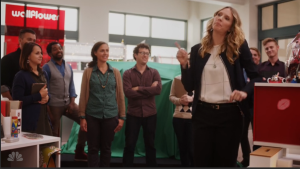“There just aren’t a ton of roles being written out there — for Asians or by Asian-Americans,” says actress Diane Mizota. She’s friends with actor Aaron Takahashi, who was in Kevin Hart’s “The Wedding Ringer.” While that is not a movie she would normally see, she went out to see it opening night with him and several others.
“I think we have to be supportive so more roles get made.” Mizota believes the support among Asian-Americans in the industry goes a long way.
“The thing that’s so hard is that it’s not up to the actors to change things. It’s up to the creators. If you really want to change things in Hollywood, be a creator. Be a content creator,” she advises. “Write scripts, get into producing, be an executive who can make decisions and include more diversity.”
The actors talk about ways that we can reverse a lack of representation and stereotypes:
*If video does not work, click on this link
Sono Patel is an Indian-American screenwriter who wrote for NBC’s sitcom, “A to Z.” She believes that, as a writer, she can influence change to an extent. She mentions two Asian characters on the show, and how the writers always tried to give them great lines and stories.
“We did feel a responsibility to them because we know that many people will form opinions of entire races based on those two in a way they wouldn’t with white characters,” she explains. “They were really fun characters, and we gave them extra care because of their races.”
However, she believes that those who can affect the most change in Hollywood are audience members.
“This is an industry of supply and demand. Execs at studios and networks are always trying to figure out what their audience wants,” she says. “That’s their main goal, so if the audience decides it wants more Asian characters, or more female leads — or whatever — the powers that be will fall in line.”
Still, she thinks that producers-directors-writers should keep trying to push for more diverse characters, especially if that character doesn’t have to be a certain race.
“Why not make them Asian? Why not make them black? Why default to Caucasian actors?” she asks.
The Screen Actors Guild commissioned a 2010 study, “From Dollars & Sense to Screen: The Asian Pacific Islander Market and the Entertainment Industry.” The report assesses the current trends of Asian Pacific Islander (API) consumers of film, television and new media. The study notes that APIs are one of the most lucrative market segments in the world; they have one of the fastest population rates and some of the highest annual household incomes.
“For a market so rife with opportunity, however, the U.S. entertainment industry has been slow to target and incorporate the consumer interests of the API demographic. Images, representations and stories of APIs in film and television are disproportionately below the API percentage of the general U.S. population,” the report notes. “Mainstream films and television shows specifically featuring APIs are practically non-existent, yet API consumers continue to grow in both numbers and income.”
The report points out that neglecting this quickly growing market could cost the entertainment industry significant business profits and revenue.
A study done at UCLA’s Ralph J. Bunche Center for African American Studies shows that people want diversity in entertainment. The study looks at more than 1,000 television shows that aired on 67 cable and broadcast networks during the 2011–12 season. The UCLA researchers found that more viewers were drawn to shows with ethnically diverse lead cast members and writers. Moreover, shows that don’t reflect diversity attracted fewer viewers.
Economically speaking, therefore, if this is what people want, the demand will be there for more Asian-American characters.
“On the one hand, you may have writers, producers and casting directors looking for something very specific and authentic,” says Adam Moore, national director of Equal Employment Opportunity and Diversity for SAG-AFTRA. “When it comes to commercials and television, a lot more than film, you’re seeing stuff that’s not so specific.”
He believes that Hollywood is opening up more.
“Today, the opportunities for people who don’t fit in neat boxes have increased because there are more and more boxes,” he says. “There are more communities coming out with content. There is more opportunity to just play people.”
As far as stereotypes go, Patels thinks writers, actors and creators should aim higher.
“Try not to take those jobs [that promote stereotypes] if you can get away with it,” she says.
Her strongest point of advice, though, is for viewers. She thinks they need to avoid watching content that features stereotyped or problematic portrayals.
“The truth is that networks are afraid of their audience because they’re chasing ratings which equates to ad money, so if their audience keeps flocking to shows with stereotypes, they will keep making them,” says Patel.
“We’re there to do a job because the network feels that there’s money in that content. So yes, we are to blame for literally creating this content, but it comes from the audience asking for it. So again, if you’re a viewer, stop watching subpar content.”

